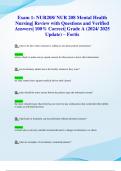Exam (elaborations)
Test Bank For Pathophysiology Concepts of Human Disease, 1st Edition (Sorenson, 2019), Chapter 1-53 | 9780133414783 | All Chapters with Answers and Rationals
Test Bank - Pathophysiology-Concepts of Human Disease, 1st Edition (Sorenson, 2019), Chapter 1-53 | All Chapters
[Show more]












